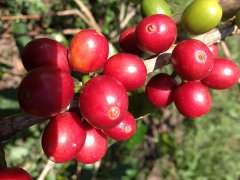Three hundred years of inheritance of Kakeda roast Malawian coffee Mzuzu Coffee in Kyushu Prefecture, Japan
Professional barista communication, please pay attention to coffee workshop (Weixin Official Accounts cafe_style)
The Oura River, about 20 kilometers north of the city of Hita, is rich in soft clay. At that time, officials of Hita City hoped to produce some articles of daily life, so they invited the pottery master Yanagase Sanemon to cooperate with Kuroki Shibei, and Sakamoto in Minyama provided land to make utensils needed for production. It has been handed down from generation to generation for more than 300 years. In addition, the name of the family is the name of the family, and the name of the family is a branch of the Kuroki family.
Lu Tianshao has been inherited for 300 years, refusing the temptation of the outside world, still surviving on this land. Local professionals dig clay from the valley, contact the local river to grind the clay into pottery powder, use the wheel driven by feet, ancient kiln and fire wood to heat the firing method, even the final burning process needs to be guarded by the professionals themselves. In the sixth year of Zhaohe, Liu Zongyue came here and praised,"In a word, this is more beautiful than the most advanced technology." The sound of pounding the earth was also selected as the "Japanese Voice 100 Scenery Selection."
Malawi AA
Mzuzu is the capital of Malawi's northern region and is Malawi's third largest city by population.
Most of Malawi is located above high mountains, so the climate in most parts of the country has significant vertical differences. It has a highland climate in the tropical dry and wet seasons. Generally speaking, the temperature in the alpine plains is very mild and stable, but the temperature in winter can be as low as 4 degrees Celsius. The temperature in the basin is relatively hot, with the hottest temperature being 39 ° C, and the annual rainfall varies according to the geographical environment, ranging from 600mm to 3000mm on average. The rainy season usually starts from November to May, and rainfall from May to November is very low. Malawi is located on a plateau, so it is rarely threatened by hurricanes and floods.
Malawi coffee has been on the rise in recent years. Since the global coffee market has been booming since the 1990s, Malawi has been on the opposite decline. The annual output of 7720 tons in 1991 dropped to 3703 tons in 2001. The annual output dropped to 2500 tons in 2007, while the export volume was only 1307 tons. In response to the decline, Malawi Investment Promotion Bureau cooperated with the "Sustainable Growth Program (GSB)" under the United Nations Development Programme and the United States Agency for International Development. Co-marketing Malawi coffee. Malawi was also positioned as a major coffee producer in the world.
Mzuzu Coffee is managed by close to 4000 smallholder coffee growers, growing at altitudes between 1,500 and 2,600 meters, in terraced canyons or on contour lines, often using artificial irrigation. At the same time, depending on its characteristics, growers provide different gaps, usually relying on organic fertilizers for planting. Unlike the rest of Malawi, Mzuzu Coffee is grown entirely with Arabica varieties such as New World (Old Variety), Agaro, Rosedale and high quality katim. To avoid affecting coffee quality, farmers usually pick coffee cherries from 6 a.m. and process them within 6-8 hours. To ensure excellent flavor, farmers only pick cherries when they are ripe to red.

Important Notice :
前街咖啡 FrontStreet Coffee has moved to new addredd:
FrontStreet Coffee Address: 315,Donghua East Road,GuangZhou
Tel:020 38364473
- Prev

The difference between honey treatment and sun treatment, Black Honey at La Jas Manor in the Central Valley of Costa Rica
For professional baristas, please follow the coffee workshop (official Wechat account cafe_style) Black Honey Costa Rica Finca las lajas flavor of La Jas Manor in the Central Valley of Costa Rica: sweetness, syrup, fruit aroma, cherries (also understood as sour apples), strawberries characterized by heavy fermentation, thick and thick texture, shallow roasting with fermented grapes and some strawberries
- Next

Dorima, Colombia-Fenka St. Louis Manor Information introduction 100% Iron pickup Coffee Classic style
For professional baristas, please follow the Coffee Workshop (Wechat official account cafe_style) Fenka St. Louis Manor in Dorima, Colombia. Introduce Omar Arango, owner of Fenka St. Louis, Colombia, who has grown coffee for more than 30 years and is committed to improving the treatment to get the best flavor. Fenka St. Louis Manor
Related
- Detailed explanation of Jadeite planting Land in Panamanian Jadeite Manor introduction to the grading system of Jadeite competitive bidding, Red bid, Green bid and Rose Summer
- Story of Coffee planting in Brenka region of Costa Rica Stonehenge Manor anaerobic heavy honey treatment of flavor mouth
- What's on the barrel of Blue Mountain Coffee beans?
- Can American coffee also pull flowers? How to use hot American style to pull out a good-looking pattern?
- Can you make a cold extract with coffee beans? What is the right proportion for cold-extracted coffee formula?
- Indonesian PWN Gold Mandrine Coffee Origin Features Flavor How to Chong? Mandolin coffee is American.
- A brief introduction to the flavor characteristics of Brazilian yellow bourbon coffee beans
- What is the effect of different water quality on the flavor of cold-extracted coffee? What kind of water is best for brewing coffee?
- Why do you think of Rose Summer whenever you mention Panamanian coffee?
- Introduction to the characteristics of authentic blue mountain coffee bean producing areas? What is the CIB Coffee Authority in Jamaica?

